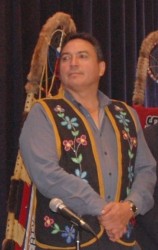Article Origin
Volume
Issue
Year
Prime Minister Justin Trudeau has pledged to end all boil water advisories on First Nations within five years.
The budget delivered by his government on March 22 committed $1.8 billion to strengthen on reserve water and waste water infrastructure and $141.7 million to monitor water on reserve. Both commitments are over a five-year period beginning in the 2016-17 fiscal year.
Meeting that five-year goal “is a challenge,” said Assembly of First Nations National Chief Perry Bellegarde, who points out that of 634 First Nations, 132 have boil water advisories in place. Some communities have had boil water advisories for 20 years.
“That’s not acceptable. So get to the table, put a strategic plan in place, make sure the proper fiscal resources are there and let’s get this done,” said Bellegarde.
Nicole Hancock, executive director with Safe Drinking Water Foundation, says if the federal government “spends the money in the right way” it will have a positive impact on resolving the issue.
“Sometimes statements that governments have made in the past have not been held to,” she said. Hancock also questions whether the government will be able to fully deliver funding considering part of the five-year timeline comes after the 2019 federal election.
There is no one-solution-fits-all remedy to the issue of safe drinking water, Hancock says.
“There are complex reasons for boil water advisories,” she said. Among the factors that must be taken into consideration are population, location, geography, and water source.
In an article published last October in Macleans magazine, Foundation board member Dr. Lalita Bharadwaj said leadership also had to be taken into consideration.
“Based on our research, there have been over 10 years of policies developed from 2001 to 2013, and it’s clearly shown that the approaches have not yet made a difference within the First Nations communities,” said Bharadwaj. “There needs to be an understanding that we have 600 First Nations and they are not homogenous, and one top-down approach will not address the issue. There needs to be more individual consultations with each community.”
The unique needs of First Nation communities are demonstrated by the different measures already in place to deal with the issue of safe water.
In Ontario, the Tribal Council of Keewaytinook Okimakanak has implemented the Safe Water Project. The program was developed by the KO chiefs in response to the water challenges their six First Nations were facing. The project is building long-term capacity by training Indigenous people to become water operators, while simultaneously providing the operational support and technology required to end boil water advisories in the short-term. So far, the program has been successfully implemented in five First Nations, and it is expected that North Spirit Lake First Nation will have its 15-year-old boil water advisory lifted in the next few months. Other First Nations in Ontario, as well as in British Columbia, have expressed interest in implementing KO’s system.
In Saskatchewan, 14 First Nations have employed the Integrated Biological and Reverse Osmosis Membrane treatment process, which was developed at Yellow Quill First Nation from 2002 to 2004 by Dr. Hans Peterson, volunteer scientist with the Safe Drinking Water Foundation. The treatment process is also operational in one First Nation in Alberta, and scheduled for construction in 2016 on two other First Nations in Saskatchewan.
Hancock points out that communities need water that tastes good as well as is safe.
Hancock says the budget is unclear as to how the $1.8 billion will be spent.
The document states, “Budget 2016 proposes to address health and safety needs, ensure proper facility operation and maintenance, and end long-term boil water advisories on reserves …”
“The way it’s worded, facility operation and maintenance, it doesn’t sound like new treatment plants,” said Hancock.
But Hancock is confident that the dollar figure, even shared between upkeep and new facilities, is reasonable.
She also says it’s vital that ongoing monitoring of water takes place.
“Because even if their water meets the current Canadian guidelines for drinking water quality, it might not meet the proposed guideline… because often they’re finding out new things about the different components of the water and they’re finding out different health effects they have and the levels they need to be at,” said Hancock.
- 1927 views

